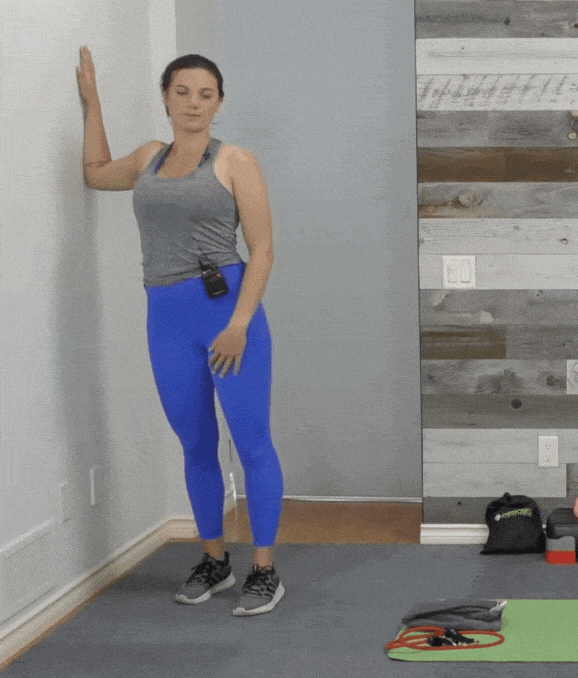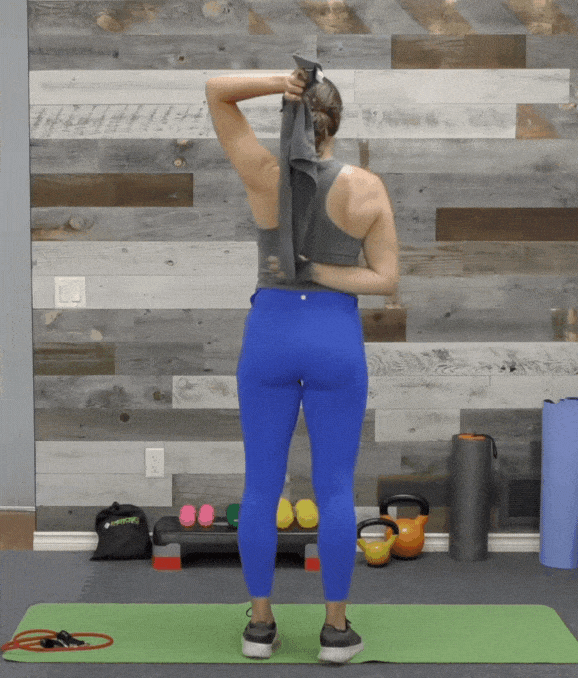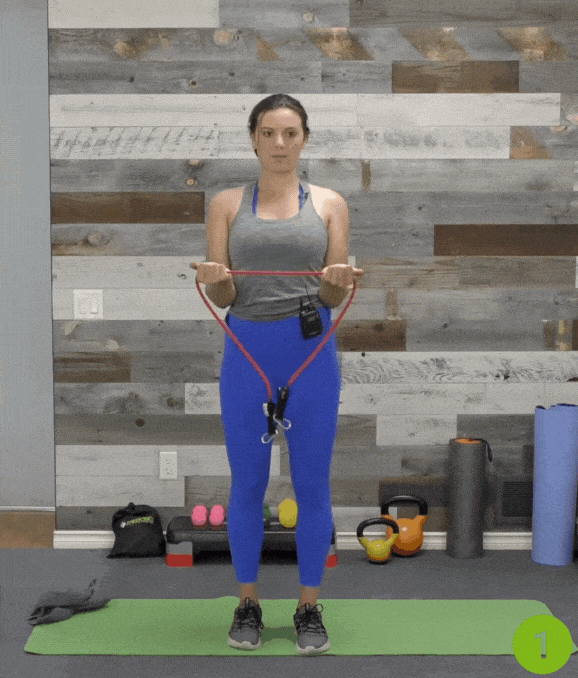Frozen shoulder — also called adhesive capsulitis — is no joke. This painful condition leaves your shoulder joint stiff, immobile, and frustratingly limited in motion. It can sneak up gradually, and if you ignore it, you might face months or even years of reduced shoulder mobility, aching shoulder pain, and reduced muscle use
The good news? You don’t have to live in agony. Specific, research-backed exercises for frozen shoulder [1] can dramatically improve your shoulder’s range of motion, reduce pain, and help restore strength.
Before you get started, apply a hot pack to your affected shoulder for 10–15 minutes. Applying heat increases blood flow, relaxes the soft tissues around the joint capsule, and primes your body for these stretching exercises.
Below is your pain-free, step-by-step blueprint. These moves are designed to target the shoulder joint, boost synovial fluid circulation, help reduce stiffness from adhesions, and improve flexibility.
1. Pendulum Stretch
- Stand tall, feet hip-width apart, one hand on a chair for balance.
- Bend forward slightly, letting your affected arm hang freely.
- Gently swing the arm in small circles, gradually widening the circles as tolerated.
- Do not force motion or push into pain.
This exercises for frozen shoulder improves synovial fluid flow, helping lubricate your shoulder capsule.
2. External Rotation (Doorway Stretch)

- Stand in the doorway, elbow bent at 90 degrees against the frame.
- Step forward slightly, feeling a gentle stretch across the front of your shoulder muscles.
- Hold for 10 seconds, repeat 5 times.
3. Towel Stretch

- For this exercises for frozen shoulder, grab a towel over your good shoulder.
- Reach behind your back with the affected arm to grip the towel.
- Gently pull upward with your good arm, stretching the frozen shoulder.
- Hold 20 seconds, repeat 10–15 times.
4. Forward Flexion Stretch
- Lie on your back, legs straight.
- Use the unaffected arm to lift the injured arm straight overhead.
- Hold for 20 seconds, repeat 5 times.
5. Finger Walk (Wall Crawl)
- Face a wall at arm’s length.
- Walk your fingers upward until you reach shoulder height or your maximum gentle stretch.
- Slowly lower and repeat 10–20 times.
6. Cross-Body Shoulder Stretch
- Bring the affected arm across your chest.
- Use the other arm to pull it closer gently.
- Hold for several deep belly breaths, then release.
7. Outward Rotation with Resistance Band

- For this exercise for frozen shoulder, keep your elbows at 90 degrees by your sides.
- Hold resistance tubing in both hands.
- Pull your hands apart, feeling a stretch across the posterior shoulder and scapular region.
- Hold 5–10 seconds, repeat 5 times.
8. Inward Rotation with Resistance Band
- Anchor the band to a doorknob.
- Hold the free end in the affected arm, elbow bent at 90 degrees.
- Pull the band inward across your body toward your abdomen, keeping your elbow at your side.
- Hold for 5–10 seconds, and repeat 10–15 times.
Dr. Jaclyn Smulofsky, PT, DPT, a physical therapist at the Hospital for Special Surgery (HSS) in New York City, emphasizes the importance of early intervention for frozen shoulder.
She notes that while the condition can be quite painful, initiating physical therapy and specific exercises promptly can accelerate recovery.
Dr. Smulofsky advises that certain treatments are time-sensitive, meaning the earlier they are started, the better the recovery outcome. Therefore, it’s crucial to consult a professional if you suspect you may be experiencing frozen shoulder
What Is Frozen Shoulder, and Why Does It Happen?
A frozen shoulder [2] happens when the joint capsule thickens and stiffens, forming fibrous adhesions that restrict joint movement and scar tissue that restricts motion. Inflammation, lack of movement, and reduced synovial fluid lead to more stiffness.
It generally goes through three phases:
- Freezing: intense pain, less motion
- Frozen: pain stabilizes, but mobility stays limited
- Thawing: gradual return of flexibility
Risk factors include diabetes, thyroid disease, soft tissue injuries, and even prolonged immobilization after surgery. In rare cases, persistent symptoms could signal something more serious, like tumors, so always consult a doctor or orthopedic surgeon if you do not improve.
How to Supercharge Your Frozen Shoulder Recovery
- Always stay in a pain-free range of motion — don’t push through severe pain.
- Warm up with heat before starting exercises.
- Start with passive range, then progress to active range motions.
- Work with a physical therapist to customize a shoulder mobility program.
- Consider dietary supplements and anti-inflammatory foods to support healing.
- If symptoms persist, ask about steroid injections or even minimally invasive surgery (small incisions) to release adhesions.
Diagnosis & When to See a Doctor

A frozen shoulder is typically diagnosed through a physical exam and review of medical history. In some cases, imaging tests like X-rays or MRIs are used to rule out other conditions.
Important: In rare cases, persistent frozen shoulder symptoms may be misdiagnosed and could indicate more serious conditions like tumors. Consult a doctor or orthopaedic surgeon if your symptoms don’t improve or worsen over time.
Key Tips for Safe Recovery
- Always perform exercises within a pain-free range. Avoid pushing into pain—it leads to worse outcomes.
- Start with passive range exercises, then progress to active range as your shoulder strengthens.
- Consult a licensed physical therapist for guided progression and personalized support.
- Massage and applying heat before stretching helps reduce tension and improve flexibility.
Conditions That May Increased Risk
Certain chronic conditions, such as diabetes, thyroid disorders, and cardiovascular issues, can increase the risk of developing a frozen shoulder. Post-surgical immobility and soft tissue injuries like rotator cuff damage may also contribute.
Other Treatment Options
- Steroid injections [3] to reduce inflammation.
- Dietary supplements (e.g., turmeric, omega-3) may support joint health.
- Surgery, in rare cases, minimally invasive surgery may be performed to release adhesions or address persistent restrictions.
- Physical therapy home program for ongoing maintenance.
Final Takeaway
The frozen shoulder might seem unbreakable, but science has shown that these specific exercises for frozen shoulder can transform pain, rebuild flexibility, and even help prevent future issues.
By moving gently, respecting your pain limits, and staying consistent, you can get your shoulder joint moving freely again. Imagine lifting your arm without wincing, picking up the groceries, hugging your kids — all pain-free.
Frozen shoulder can be miserable! Check out this Frozen Shoulder Solution now!
Frequently Asked Questions
Can a frozen shoulder cause cancer?
Extremely rare — but get imaging tests if you don’t see improvement.
Fastest way to heal a frozen shoulder
The fastest approach includes physical therapy focused on stretching and mobility, anti-inflammatory medications, and in some cases, corticosteroid injections. Consistency in exercises is key.
Is it OK to massage a frozen shoulder?
Yes, gentle massage can help relieve pain and improve circulation, but it should be done carefully and ideally by a professional familiar with frozen shoulder.


